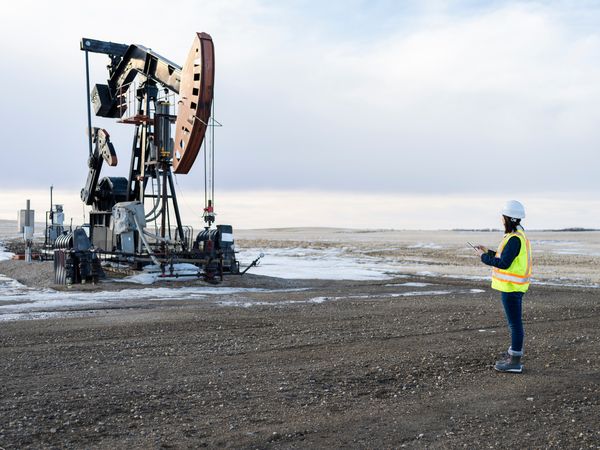Shares of the three biggest oil field services companies, Schlumberger (SLB 0.60%), Baker Hughes (BKR +0.33%), and Halliburton (HAL 0.50%), fell by double-digit percentages in January. Halliburton's shares were down 10.9%, Baker Hughes' shares dropped 15.5%, and Schlumberger's performed the worst, tumbling 16.6%.
What happened?
All three companies reported lackluster fourth quarter earnings during the month, but the primary cause of the drop seems to have been tumbling oil prices.

Image source: Getty Images.
So what?
When oil and gas prices fall, the first companies hit are production companies and oilfield services companies, with which production companies contract to provide equipment and logistics at well sites.
The conventional wisdom is that oil producers will underperform thanks to the lower prices they'll command for their products. With producers strapped for cash, the thinking goes, they'll either cut back on their purchases from the oilfield services companies, or will fight for more favorable contract terms. Both options are bad for services companies.
In early January, fears about tensions in the Middle East, particularly with Iran, sent oil prices upwards, but the effect was temporary. As U.S.-Iran concerns subsided, worries about a continuing global oil oversupply and how the Wuhan coronavirus might affect the global economy took over, sending oil prices down more than 13% for the month. The spot price of Brent Crude fell 13.6% to $58.54/barrel, while U.S.-based WTI Crude prices dropped 13.2% to $53.09/barrel. Henry Hub natural gas spot prices also declined, but only by 2.9%.
Tumbling prices affected not just the top three companies, but the sector as a whole. The S&P 1500 Oil & Gas Equipment & Services Sub-Industry Index was down 16.1% for the month. Measured against that benchmark, Halliburton actually performed comparatively well, continuing its streak of outperforming its industry.
It's a bit odd that Halliburton was the outperformer here, considering its fourth quarter 2019 performance was much worse than the other two companies':
| Company | Q4 2019 Revenue | % Change (YOY*) | Q4 2019 Net Income (Loss) | % Change (YOY*) |
|---|---|---|---|---|
| Baker Hughes | $6.3 billion | 1.3% | $48 million | (63.4%) |
| Halliburton | $5.2 billion | (12.6%) | ($1.6 billion) | N/A |
| Schlumberger | $8.2 billion | 0.6% | $333 million | (38.1%) |
YOY = Year Over Year (from Q4 2018). Data source: Company earnings releases. Chart by author.
In addition to posting a massive net loss, Halliburton was the only one of the three companies to report lower revenue than in the year-ago quarter. Its adjusted figures were much better, once $2.2 billion in severance charges and asset impairments -- mostly pressure pumping and legacy drilling equipment -- are backed out. But even on an adjusted basis, Halliburton's net income still fell by 55.8% from the prior year quarter.
Baker Hughes and Schlumberger had impairment charges of their own. For Baker Hughes, this was largely due to restructuring and separation costs as the company finished its separation from former parent General Electric.
Absent such costs, Baker's net income actually increased by 49% from the fourth quarter of 2018. For its part, Schlumberger blamed "market conditions" for its asset impairments, with adjusted net income up 9% over the prior year.
All three companies released statements expressing optimism for 2020. Baker Hughes CEO Lorenzo Simonelli claimed to see a "macro environment that is slowly improving."
The other CEOs didn't go quite that far, with Schlumberger CEO Olivier Le Peuch and Halliburton CEO Jeff Miller each declaring that his company was anticipating margin expansion, improving returns, and growth in free cash flow. Yes, they each literally listed those three items, in that order.
Now what?
Baker Hughes didn't break out its numbers by region, but for Halliburton and Schlumberger, North American revenues were down, while revenues in the rest of the world were up. It seems likely that Baker Hughes is probably facing the same trend. However, North American revenues make up a large portion of each company's business -- about 33% of Schlumberger's and 44% of Halliburton's.
The trend of negative North American growth coupled with positive international growth is expected to continue into 2020, so international growth should be able to offset North American declines, but it's not a sure thing.
Investors may want to keep these companies -- indeed, this entire industry -- on their watch lists for now, until we get a clearer picture of what's happening in the oil markets.









